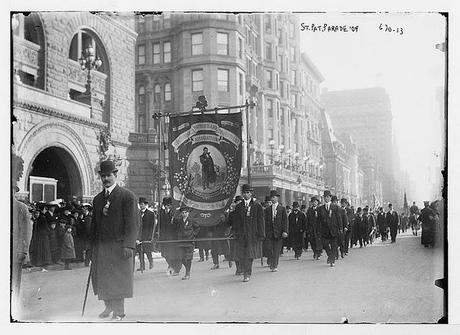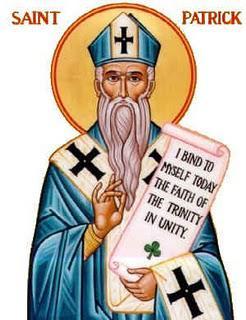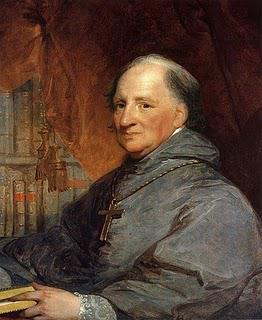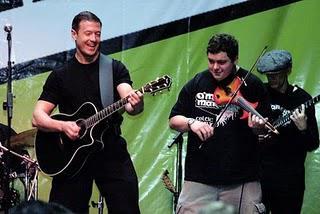
Saint Patrick's Day in New York's Fifth Avemue, 1909.
What has become of “my people’s” annual national and cultural holiday, Saint Patrick’s Day? Americans of Irish ancestry (and, ‘tis said, those who wish to be Irish) attempt to honor their heritage on a Catholic feast day, March 17, but the day now is as Irish as the Great Saint was himself, that is to say, NOT.

Saint Patrick in traditional blue.
The green came later.
Saint Patrick, the actual man, was a 5th century Welsh son of a Roman Empire functionary, kidnapped and sold into slave labor across the Irish Sea. After escaping, he became a priest and bishop, returned to Ireland, and worked to convert the heathen in the last wild west of Europe. This conversion – led by Ireland’s three patron saints, Patrick, Brigid of Kildare (Feast Day February 1), and Columba (Feast Day June 9) – gave the Irish people a faith and culture to survive repeated deprivations, preserve in manuscripts the Scriptures, literature, and theology of the Western Church after the fall of Rome, and eventually flourish in a now 1500-year diaspora spanning not only the United States but also Canada, the United Kingdom, most of the rest of the British Commonwealth, and even Argentina, Chile, Mexico, and Puerto Rico. Traditional iconography depicts Patrick in blue, not green.
Green beer and rivers? Rivers of green beer? Leprechauns, big green hats with buckles, green tinsel wigs, and “Kiss Me, I’m Irish” tee-shirts? What do any of these things – as offensive as a Washington Redskins jersey to a member of the Lakota people – have to do with Patrick, Ireland, or the sons and daughters of Erin’s green shore?
The Irish began showing up in America long before the Great Famines of the mid-19th century. As one example, the Carrolls from County Tipperary played important roles in the American Revolution. Charles Carroll of Carrollton, Maryland, was the only Catholic signator of the Declaration of Independence. His cousin Daniel Carroll, became a Maryland state senator after laws against Catholics holding office were repealed in 1776, signed the Articles of Confederation and Constitution, and pushed Thomas Jefferson to sack Pierre L’Enfant as the designer for the Federal City when L’Enfant knocked down an addition to the Daniel Carroll manse. (The house allegedly encroached on a planned but yet un-built street that is now New Jersey Avenue, S.E. on Capitol Hill). Daniel’s younger brother, John Carroll, a Jesuit priest, founded Georgetown University, and became the first bishop in America in Baltimore in 1789 (during the time of the Jesuit suppression in Europe of 1773-1814).

Baltimore Archbishop John Carroll,
as painted by Gilbert Stuart.
But I digress, being proud of my Irish heritage (and that was just one family! Wait until Ken lets me post about me own!).
Like most immigrant groups, we Irish have sought to retain memories though groups and events celebrating our origins and identity. Some Bostonians claim credit for the first Saint Patrick’s Day Parade in 1737, organized by Boston’s “Irish Society” as a political protest against low social status and scarce jobs. After 1776, Bostonians began coupling the Saint Patrick’s Day celebration with the March 17 anniversary of the British leaving town after the Siege of Boston that year. What makes a better pan-historical mix than being Irish and/or beating the English in Beantown?
In New York City, the first Saint Patrick’s Day parade came on March 17, 1762, staged by Irish soldiers then serving in the British Army. Parade organizers claim that today’s, in 2011, marks the 250th time the grand procession will march up 5th Avenue. With its formal review by New York’s Archbishop Timothy Michael Dolan from the steps of Saint Patrick’s Cathedral (considered by New Yorkers the mother church in the United States – Baltimoreans may quibble), the New York Parade is certainly one of the largest by number of participants in the world. (See photo from the 1909 parade above.)
In 1780, General Washington himself formalized the celebration by issuing an order allowing his troops to celebrate on March 17 “as an act of solidarity with the Irish in their fight for independence” and commended the Irish Parliament in their attempts “to remove those heavy and tyrannical oppressions on their trade” imposed by Great Britain. (Click here to see the handwritten original.)

Maryland Governor Martin O'Malley with his band.
Saint Patrick’s Day parades have been established in cities across the country, from Alexandria to Baltimore, Buffalo, Charleston, Cleveland, Milwaukee, New Orleans, Pittsburgh, Saint Paul, San Francisco, Savannah, Scranton, Seattle, Syracuse, and many, many more. And these parades quickly became grand stages for the practice of one of America’s great home-grown sports – politics. Candidates came to march and wave at the crowds, kiss babies, slap shoulders, and refine the art of person-to-person organizing that was the lifeblood of American elections from before the time of Tammany Hall in the 1800s to the present Governor of Maryland, Martin O’Malley (who also has his own Celtic rock band).In New York, even the Stock Exchange closed on Saint Patrick’s Day up until the mid 20th century, by tradition to accommodate the largely-Irish back-office staffs that left for the parade at lunchtime and did not come back. Since 1991, the United States Congress has built March 17 into a full Irish Heritage Month and Presidential Proclamations follow suit.
In recent decades, the same relentless force of American commercialism that has turned Christmas, Thanksgiving, and even Halloween (all originally more solemn religious or national holidays) into shopping opportunities has focused on this observance of my heritage. It’s annoying and distracting, but some of us remember what the Great Saint brought to our forbearers.
The several strains of my family came to America, struggled, and (Deo gratia) succeeded, like many other immigrants. Today I am tremendously grateful for that, inordinately proud of my family and my people, and finally look forward to peace and prosperity on the entire island of Ireland. That party we throw with all of the Guinness and whiskey every year? We’re just trying to do our part for the Irish economy. Lord knows it could use the help.
David Durkin, a Washington attorney and cultural savant, hosts the best Saint Patrick's Day bash in DC. Visit him at his web site at OFWLaw.com

